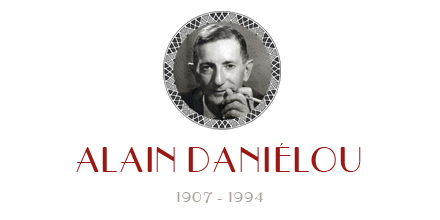EDITO
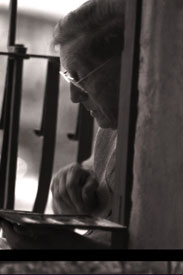 We are dancing – or rather waging war – on the edge of a volcano, without considering the really serious problems that are looming and above all without reacting to the sad state of our planet. The Kali Yuga is, nevertheless, a present reality that Alain Daniélou often spoke of, particularly in his book “While the Gods Play – Shaiva Oracles and Predictions on the Cycles of History and the Destiny of Mankind”, which could have been entitled “Apocalypse Now”, if the title had not already been used.
We are dancing – or rather waging war – on the edge of a volcano, without considering the really serious problems that are looming and above all without reacting to the sad state of our planet. The Kali Yuga is, nevertheless, a present reality that Alain Daniélou often spoke of, particularly in his book “While the Gods Play – Shaiva Oracles and Predictions on the Cycles of History and the Destiny of Mankind”, which could have been entitled “Apocalypse Now”, if the title had not already been used.
Among the problems worrying the Daniélou Centre during the coming year, in the front line I should place pollution and over consumption. I should therefore like to ask everyone receiving this letter by post to give us their e-mail address, or that of a neighbour, or friend, or even to consult our site, so that we needn’t use up paper for printing an ephemeral document which does not need it. It is merely a tiny drop compared to our immense ecological problems, but it is a sign – and not the only one – among the various measures we take every day.
The request for our information letter is continually increasing, showing the growing interest roused by Alain Daniélou’s work in all the fields he wrote about.
We have already begun preparing events and planning new publications and re-issues for 2007, the year in which we shall commemorate the one hundredth anniversary of Alain Daniélou’s birth.
On the very date of the Winter Solstice – today, December 21st at 7.35 p.m. CET – the whole team at the Labyrinth unites with me in wishing you a happy festive season, in the hope that the ascendant half-year (for the northern hemisphere) or the descendent (for the southern) will bring you happiness, serenity and harmony.
Jacques E. Cloarec, The Labyrinth, on the day of the Winter Solstice 2005.
ACTUALITÉS
– L’HISTOIRE DE L’INDE
 The club edition of Alain Daniélou’s book “Histoire de l’Inde” will be published in the magazine “Club Histoire” (by GLM) for the month of February 2006.
The club edition of Alain Daniélou’s book “Histoire de l’Inde” will be published in the magazine “Club Histoire” (by GLM) for the month of February 2006.
EXPOSITIONS
– The exhibition “Alain Daniélou sur les routes de l’Inde” which opened on October 5th 2005 will continue up to February 4th 2006 at La Maison des Indes under the direction of M. Gaël de Graverol. Commissaire: Simon Hamelin.
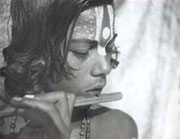 In 1936, Alain Daniélou started out on a long world tour, with a final stop in India. Accompanied by his photographer friend Raymond Burnier, he strode the roads of the subcontinent seeking “a world through the looking-glass”, far from the great truisms frequently transmitted on the subject. Impressed by his first sensorial and intellectual experience of India, Daniélou continually returned to the subcontinent, visiting its holy places, frequenting its thinkers, spiritual masters and artists, taking many photographs and – above all – writing. His glance is without complacency and is full of respect and fascination for the peoples, the monuments and the landscapes he discovers.
In 1936, Alain Daniélou started out on a long world tour, with a final stop in India. Accompanied by his photographer friend Raymond Burnier, he strode the roads of the subcontinent seeking “a world through the looking-glass”, far from the great truisms frequently transmitted on the subject. Impressed by his first sensorial and intellectual experience of India, Daniélou continually returned to the subcontinent, visiting its holy places, frequenting its thinkers, spiritual masters and artists, taking many photographs and – above all – writing. His glance is without complacency and is full of respect and fascination for the peoples, the monuments and the landscapes he discovers.
The picture of traditional India presented in this exhibition includes some of the finest plates made by these two travelling companions and is a true “eulogy of what is different”. The photographs of Daniélou and Burnier may well function as the eye of the gods, but it is an eye that not only sees, but also hears and listens.
PRESS
Memories of India:
In 1936, two photographers in search of adventure, Alain Daniélou and Raymond Burnier, started off on a long tour of the world. They soon fell for the charm of India and its traditions, and were fascinated by its people and the landscapes they passed through, which they never stopped photographing for months.
A score of black-and-white plates of this last stage of their journey are now being exhibited at the Maison des Indes (Paris – VIè arondissement): monuments, boats laden with goods sailing up the Ganges, festivals, including the Festival of Spring or of the Humble. On this latter occasion, servants are entitled to heap insults on their masters and everyone plays at sprinkling coloured dyes. Just as many live shots to be admired, drinking a graciously proffered tea with cloves. Their photos show a country full of religion, rites and customs, with an aesthetic sense that makes one momentarily forget its poverty.
Flavie Novelli, Le Parisien Supplément, 19 oct 2005
– Concert Amelia Cuni
Amelia Cuni is a dhrupad singer living in Berlin and teaching Indian singing at the Vicenza Conservatorium. She’s presently working on a New Music production: the 18 microtonal ragas by John Cage (see description below) produced and premiere by Maerzmusik in Berlin. Cage does not give any texts for his ‘ragas’ in the SONG BOOKS but only graphical notations of microtonal series among which the performer has to choose and build up ragas. For some ragas, She has written texts herself while others uses vocalizations or Indian songs fragments. Since Cage has often used other authors’ writings also in a self-referential manner, she will use a few phrases from some of Danielou’s writings (in various languages) describing Indian music principles.
JOHN CAGE
18 MICROTONAL RAGAS:
SOLO 58 from SONG BOOKS (1970)
realized and interpreted by dhrupad singer AMELIA CUNI
produced by MAERZMUSIK, Berlin 2006
Premiered on March19th, 2006 at MAERZMUSIK / BERLINER FESTSPIELE (www.maerzmusik.de)
Performers:
Amelia Cuni: dhrupad vocals
Ray Kaczynski: percussion
Federico Sanesi: percussion
Werner Durand: drones/electronics
ZOOM SUR
Source: The Hindu Magazine
Indian musical notes in Venice
DINESH C. SHARMA
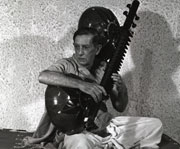 Indologist Alain Daniélou had a priceless collection of information on Indian music. Now the East Institute in Venice is cataloguing and digitising his collection. The city, a melting pot of art, cinema, music, theatre, literature, is home to several museums, galleries, research institutions and non-profit foundations dedicated to conservation and promotion of different arts and cultures. One such organisation is the Fondazione Giorgio Cini or the Giorgio Cini Foundation, housed on the isle of San Giorgio Maggiore. The institutes are dedicated to art history, history of Venetian state, opera and music, comparative music and Eastern and European studies.
Indologist Alain Daniélou had a priceless collection of information on Indian music. Now the East Institute in Venice is cataloguing and digitising his collection. The city, a melting pot of art, cinema, music, theatre, literature, is home to several museums, galleries, research institutions and non-profit foundations dedicated to conservation and promotion of different arts and cultures. One such organisation is the Fondazione Giorgio Cini or the Giorgio Cini Foundation, housed on the isle of San Giorgio Maggiore. The institutes are dedicated to art history, history of Venetian state, opera and music, comparative music and Eastern and European studies.
The Venice and the East Institute was founded in 1958 to promote studies on India and the Far East. Its interest in India is not just academic. This institute, as well as the Intercultural Institute of Comparative Musical Studies, have a unique connection to India. The common link is Alain Daniélou, the France-born Indologist and musicologist whose India connection dates back to the first half of the 20th century. Daniélou (1907-1994) lived in India for many years — first at Shantiniketan where he was appointed director of the music school by Rabindranath Tagore and then at Benaras Hindu University as head of the College of Indian Music.
In Benaras Daniélou came in close contact with Karpatriji Maharaj, who inducted him into the Shaivite school of Hinduism and he was renamed Shiv Sharan. After leaving Benaras, he was also the director of Sanskrit manuscripts at the Adyar Library in Chennai for some time. He returned to Europe in 1960s and was associated with UNESCO for some years. While in Europe, Daniélou was credited with bringing Indian music to the Western world. This was the era when sitar maestro Ravi Shankar and several other Indian artists performed in Europe and America. During his years in India, Daniélou studied Indian music tradition, both classical and folk traditional, and collected a lot of information from rare books, field experience, temples as well as from artists. He also collected various types of instruments.
UNIQUELY PRESERVED
All this information was preserved in a unique form — hand written and typed cards (in Devanagiri and English). Many cards and paper sheets contain iconographic information. The sheer number of these cards and paper sheets is amazing — some 3,00,000! Daniélou donated this priceless repository of information, along with his collection of books on India and Asia, to the East Institute during his lifetime. His connection with Venice was old — he had set up the Intercultural Institute of Comparative Music Studies at Venice and Berlin in 1970. The Venice wing of this Institute became part of the Cini Foundation in 1999.
“These fragile cards and paper sheets on which Danielou and other pundits in India wrote down old references to Indian music from all primary Indian sources, are rare documents,” said Prof Alfredo Cadonna, director of the East Institute and a professor of the history of Chinese philosophy and religions at the University of Venice. The institute has begun conversion of this material into digital form and cataloguing the same. The first phase of the project — Alain Daniélou Indological Archives — was initiated in 2001, and now all the cards have been digitised. This was the conservation part. In the second phase, some 60,000 cards that form core of the collection will be catalogued and made available online.
The musicological archives of Daniélou are of interest beyond India. Prof Cadonna said: “The little sheets of paper actually form a thematic encyclopaedia or thesaurus for the study of Indian music and its well-known connection with Hindu thought, as well as for those studying musical and cultural traditions in China, Korea, Japan, Thailand and other countries in South East Asia.”
The first phase was completed with financial assistance from the Italian Ministry for Cultural Heritage and Activities. This was after a failed attempt to get Indian research bodies interested in the project. The Indira Gandhi National Centre of Arts, New Delhi, showed some interest in the work around 1997-98.
ABSTRACTS. Copyright: 1995 – 2005 The Hindu
– EXTRAIT DE L’ARTICLE PARU DANS LA REVUE TRIKONE MAGAZINE, JUIN 2005, U.S.A, CANADA, INDIA
Where West meets East
The amazing Alain Daniélou
Alain Daniélou did not hesitate to become one of the first to make his outing in 1981.
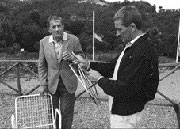 Indeed, it was during this period that he published his autobiography The Way to the Labyrinth in French – later published in English by New Directions of New York – in which he does nothing to hide his homosexuality. The French television programme “Apostrophes”, widely followed in French-speaking countries, underlined this point in presenting both book and author. We consequently find no difficulty in speaking openly about Alain Daniélou’s homosexuality and he himself was certainly not worried by the fact and accepted it with great serenity. It is because he accepted himself totally that he had the extraordinary life that was his and could write the liberating books that he wrote.
Indeed, it was during this period that he published his autobiography The Way to the Labyrinth in French – later published in English by New Directions of New York – in which he does nothing to hide his homosexuality. The French television programme “Apostrophes”, widely followed in French-speaking countries, underlined this point in presenting both book and author. We consequently find no difficulty in speaking openly about Alain Daniélou’s homosexuality and he himself was certainly not worried by the fact and accepted it with great serenity. It is because he accepted himself totally that he had the extraordinary life that was his and could write the liberating books that he wrote.
…
On his return to the West in 1958, Alain Daniélou wrote “Le Bétail des Dieux et autres Contes Gangétiques”, a charming book which has seen great success in French and is regularly republished. Its English translation – The Gods’ Livestock – is ready and awaits only a publisher.
The homosexual component of these tales is quite clear and happily recalls the sexual “atmosphere” of his life during those years in India. We can only admire the free tone of these tales when we discover that they were first published in Paris in 1962, at a time when few authors would have dared write anything so openly homosexual. I quote: “His hand caressed my back, my thigh. I felt his warm body tremble against mine. His mouth sought mine. Sweet warmth swept through me, a sort of marvellous peace entered me. My lips half-opened on his. My hands gently explored that fresh, smooth body, which gave itself to me passionately, totally, forever. I had had little sensual experience, and these marvellous moments remain in my memory, like a kind of heavenly oasis, a feeling of having caught a glimpse of the paradise of the gods.”
In the account he gave of his World Tour in 1936 (published only in French), we find a passage describing visits to a “House of Boys” in Peking:
“We plunge into narrow silent alleys covered with thick soft dust. Along the blind walls of the houses, sleeping bodies can be made out. Sometimes a great door stands ajar, covered with strange decorations. Suddenly, time is obliterated, the modern world disappears. Are we in Babylon or Palmyra? Are these Egyptians or Greeks sleeping in these narrow rooms around a square courtyard? Our half-naked slaves, dripping with sweat, lead us through forgotten worlds.
After walking long through this tangle of silent alleys, we halt before an open door. Our boys dry themselves and go on ahead. The rectangular courtyard is paved. All around are lighted rooms, closed by white curtains. One curtain is drawn aside. We are
The air is warm. We are looking for nothing, we want nothing. We slip through the centuries in a weightless world. Then again an open door guarded by stone lions, a silent courtyard, another open door. We enter and at once, clothed in black silk brocade, a fifteen-year-old boy comes forward with eyes cast down and sits beside us. “He is Manchurian”, someone says, “His father is dead and he works to keep his mother”.
“Don’t you like him?” our guide asks, surprised. “He will be very unhappy and humiliated if you just go away.”
We settle things by offering drinks for everyone, leaving a few dollars for the handsome young man and promising to come back another day. All this time, the black-garbed boy neither raises his eyes nor speaks a word. He is there, like a slave offered to the king of Egypt, simple and passive.
We get back late. In a giddy change, we find once more the trams and motor horns, the hotels and their decorum, a new world that seems so artificial, useless and barbarous, when you return from a journey through time.”
On their return to Europe in 1958, the two friends found it very difficult to get back into western society, which they found rather prudish and backward. Curiously enough, it was in the Italy of the ‘sixties and ‘seventies that they once again encountered the smiling paganism they had been so fond of in the East, with the same sexual freedom of youths always willing to be initiated into love and social life by homosexuals. How far from the gay ghettos that have arisen on the US model, which, little by little, have caused the disappearance of that specific Italian character, once common to all the peoples of the Mediterranean basin. Thus, Daniélou lived the rest of his life in a large house, lost among the vineyards near Rome. I quote from the end of his memoirs:
“The grapes have just been harvested. Le Farfardet is transformed into Bacchus. The wind is blowing through the trees. All the naked heroes, Orestes, Homer, Achilles, Hercules, have come back to life; I can hear them carousing in the swimming pool among the angels and saints of the village. Their shouts and swearing fill the air, mingling with birdsong and the rustling of leaves. In the distance lies the Eternal City, bathed in a red glow of late afternoon sun. I am too far to hear its sound and clamor.” “Between my piano and my books I have just completed the seventy-ninth turn of the spiral of my life. Here, in the heart of the Labyrinth, I have done my best to bring together these memories.”
The Way to the Labyrinth, Page 334
What is interesting about the lives of Raymond Burnier and Alain Daniélou is what might be called homosexual aesthetics, now disappearing in the West in favour of a lower-middle-class conception of homosexuality that comes from the US and transforms “gays” into a community, a minority, a ghetto. Doubtless this is necessary to obtain civil rights and the freedom to exist, but the lives of these two friends show that a different attitude is possible, that homosexuals are not there to mimic heterosexual couples, adopt children, be bound by an official marriage contract. All traditional cultures have attributed a peculiar role to homosexuals, starting from the principle that if they are part of creation, society must know why and must find for them a role that matches their specific character. Monotheistic religions bear a heavy responsibility for condemning them to an orientation that is not the right one to be taken by the homosexual community. Indeed one of the signs that shows this most clearly is the growth of bisexuality, which can find no place in the system that is now being created and would need the setting up of yet another ghetto.
Through his writings, many of which speak of sexuality in countries of the East, as well as by the example of his own life, neither hiding his homosexuality nor brandishing it like a flag, Alain Daniélou bears an essential witness to forms of culture and civilisations that are totally different from Western ethics and conduct today.
Thanks to his long sojourn in India, he shows us social organisations unlike our own, the absence of sexual taboos that are far from our own concepts. In this connexion, we may consult one of his most important works “Virtue, Success, Pleasure & Liberation – The Four Aims of Life”. In this book he wrote :
“It follows inevitably that there are also people who are neither wholly male or wholly female but have parts of both genders and are called napunsaka (nonmales). Their duties, social role, and position in society must also be different from those of other human beings.
The neuter category covers many types: eunuchs, physical hermaphrodites, and instinctual or mental hermaphrodites, who may be termed true homosexuals in order to distinguish them from bisexual men who practice homosexuality as a variant in their sexual activities.
Men with androgynous tendencies in whom certain masculine and feminine aspects are united have a special sacred character, since they symbolise the union of principles, the substance of wealth and of life. Such a man is required to be present during the performance of the sacred mysteries, and his presence is auspicious at important ceremonies, such as weddings.
Virtue, Success, Pleasure & Liberation, p. 95-96.
The mutual feelings of people who have known each other for a long time and trust one another entirely are influenced by each other. They form an indivisible unity in which contrasts no longer exist on the external level. It is at this point that friendship turns into love. Many homosexuals belong to this category, in which friendship, trust, and intimacy are also sources of love”.
Virtue, Success, Pleasure & Liberation, Inner Tradition International, 1993 p. 123
Another volume containing the texts he wrote on this subject will be published in French (December 2005) under the title “Kama et Yoga”.
Jacques E. Cloarec
Translated by Ken Hurry
Le Labyrinthe, July 2005
EN LIBRAIRIE
– Rabindranath Tagore – Song-poems.
Présentés, traduits et adaptés par Alain Daniélou, Préface de Georgette David, Editions Michel de Maule, Paris, Janvier 2005.
 Rabindranath Tagore often used to say that his songs would live in Bengal long after his name and his writing were forgotten. Although it is difficult to believe that the literary achievements of this great Bengali poet might one day be forgotten, today we see that his literary works are already considered as classics
Rabindranath Tagore often used to say that his songs would live in Bengal long after his name and his writing were forgotten. Although it is difficult to believe that the literary achievements of this great Bengali poet might one day be forgotten, today we see that his literary works are already considered as classics
that is, belonging to the past _, while his songs, sung by everyone in every part of Bengal, belong to the eternal present. During the nineteenth century, Indian classical music in Bengal developed in many ways an over-refined technique, performed only by highly trained specialists and fully appreciated only by a select audience. The musical form from created by Tagore maintains the essential features of the classical Indian system of music, but brings its rare power of expression within reach of all. Tagore was always deeply moved by the human predicament. His songs, with their simple but vigorous melodies, have given voice, expression, to the feelings of millions of men and women. These songs can be heard everywhere, in wealthy city home, in lonely rice fields, on the rivers or in the fishermen’s huts, in the village street or the university hall. Their ringing words know no difference of creed, race, caste or age.
Within a few years, Tagore’s music conquered the whole of Bengal and still pervades the rhythms of everyday life with evercherished melodies. Today, Hindu India and Muslim Bangladesh have both chosen songs by Tagore as their national anthems.
EXTRAITS
LE TOUR DU MONDE EN 1936
Éditions Flammarion, 1987.
“How much is a world tour?” Coupled with the prospect of such an improbable trip, this banal question immerses the reader in a world of pure fiction. Nevertheless, it is in actual fact the story of his world tour in 1936 that Alain Daniélou tells us, in an efficacious and simple style, illustrating the spirit of the two travellers. Free as air in both thought and deed, the two young men, Alain Daniélou and Raymond Burnier, crossed in turn the United States, Japan, China and India, before making their way back to Europe.
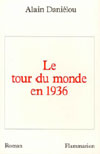 Avoiding complacency and with evident respect and fascination, Daniélou brings us a glimpse of the peoples, monuments and landscapes he discovers. This world tour is indeed a “panegyric of differences, expressing the richness of knowledge of all peoples, whose only equality lies in their beauty. On this theme, Daniélou was to become the defender of colonised peoples whose language and culture are oppressed by more powerful economies. This led him to paint a vitriolic picture of the USA, as also of European tourists and colonists in Asia.
Avoiding complacency and with evident respect and fascination, Daniélou brings us a glimpse of the peoples, monuments and landscapes he discovers. This world tour is indeed a “panegyric of differences, expressing the richness of knowledge of all peoples, whose only equality lies in their beauty. On this theme, Daniélou was to become the defender of colonised peoples whose language and culture are oppressed by more powerful economies. This led him to paint a vitriolic picture of the USA, as also of European tourists and colonists in Asia.
The detached and aristocratic attitude of the two men gives them a sometimes disdainful view of the “masses”, of whatever origin, but is never insulting nor unwarranted with regard to the inhabitants of the countries they travel through. The profound admiration shown by Daniélou for the Orient foreshadows his future sojourn in India, where he was to spend more than twenty years. Leaving aside any prophetic dimension, this tale, written during that troubled period between the two wars, when the French were almost totally in favour of holding onto their colonies, emphasises the ill-fated weaknesses and dysfunctions of the Christian West.
Eager for encounters, discoveries and beauty, Daniélou was to return to Europe with the desire to pursue his oriental peregrinations:
Deep down, for foreigners such as we have become, this western life seems hostile and superficial; and, when the sun rises mistily over the green forest of deserted avenues, we feel an obscure desire for far-off things: when are we leaving?’
The Tour du monde en 1936 by Alain Daniélou has something in common with an unbridled travel journal, in which the art of caricature is blended with a great deal of intuition.
Le Monde, October 1987.
CLIN D’OEIL
– From Bulletin N° 11 (Autumn 2005) of the Société des Amis de Gabriel Matzneff:
In September, Gabriel Matzneff delivered to Table Ronde lthe manuscript of his next novel Voici venir le Fiançé, which will be in the bookshops in the first quarter of 2006, certainly at the beginning of March.
Gabriel Matzneff began writing Voici venir le Fiançé at Naples in May and June 2004. He took up his pen again during the following winter at Marrakech, and then in the spring and summer of 2005 at Venice and at Zagarolo.
– KAMAL SINGH
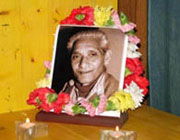 Kamal Singh et son frère Gulab furent les assistants de Daniélou et de Burnier durant leur séjour à Bénarès de 1937 à 1952.
Kamal Singh et son frère Gulab furent les assistants de Daniélou et de Burnier durant leur séjour à Bénarès de 1937 à 1952.
Kamal’s 2nd Death Anniversary Commemorated in Milan
Milan, November 28,2005
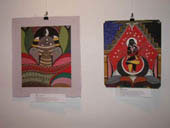 “Viamarcoaurelioventulo”, an Art Gallery in collaboration with Center Alain Daniélou has organised a twoday painting exhibition by Kamal Singh , an artist of Kashi Shaily (Kashi School of painting) on November 27 at Milan to commemorate his 2nd death anniversary. A slide show on Kamal’s life and work by Dr.(Mrs.)Alessandra Consolaro, a Hindi professor in University of Turin was presented on the occasion.
“Viamarcoaurelioventulo”, an Art Gallery in collaboration with Center Alain Daniélou has organised a twoday painting exhibition by Kamal Singh , an artist of Kashi Shaily (Kashi School of painting) on November 27 at Milan to commemorate his 2nd death anniversary. A slide show on Kamal’s life and work by Dr.(Mrs.)Alessandra Consolaro, a Hindi professor in University of Turin was presented on the occasion.
Dr. Consolaro while briefing about the artist said that Kamal who met with Picasso and collaborated Alain Daniélou and Raymond Burnier is being 40 paintings on Mythological theme and daily life of Banaras were displayed on the show. Despite of heavy snow fall in Milan, academicians, professionals from fashion world and local Indian community in large number have attended the function.
– An Italian Cultural magazine “A Oriente” published from Milan meanwhile, has announced that another exhibition of Kamal’s painting is going to be held during the month of December in its office premises at Piazza Wagner 1. Following the announcement, the exhibition will be remained open for visitors in office hours during 2 December -22 December, 2005.
Vote of the thanks to the visitors has given by Ajit Singh the painter’s son who is presently on Italian government scholarship studying Italian language at University of Perugia, Italy.
– Kashi School of Art in Zurich
Two- day exhibitions of paintings by Kamal Singh, an artist of the Kashi School of Painting inaugurated on 12 November in Zurich. The exhibition in colaboration with Aprvasi Bhartiya Sangathan , ABS was held at Swiss Federal Institute of Technology. Dr. Ashutosh Choubey, a resident Indian scientist and ABS president while inaugurating said that it is perhaps for the first time when creation of an artist touched typical style of Banaras so deeply. I admire his art work and hope this would be an inspiration to the new generation in the world of art.
